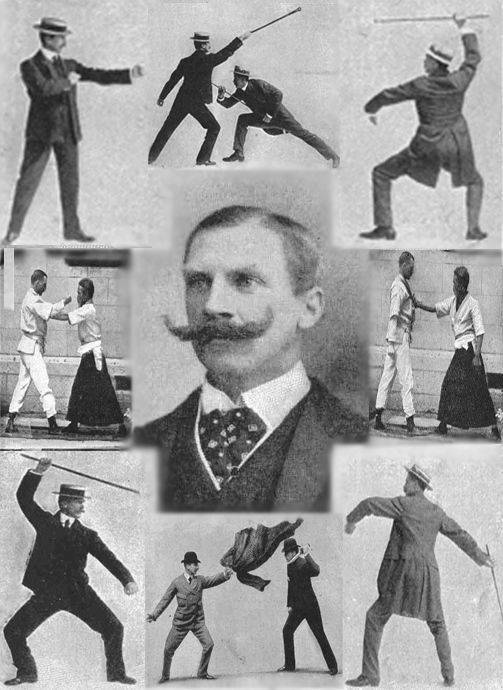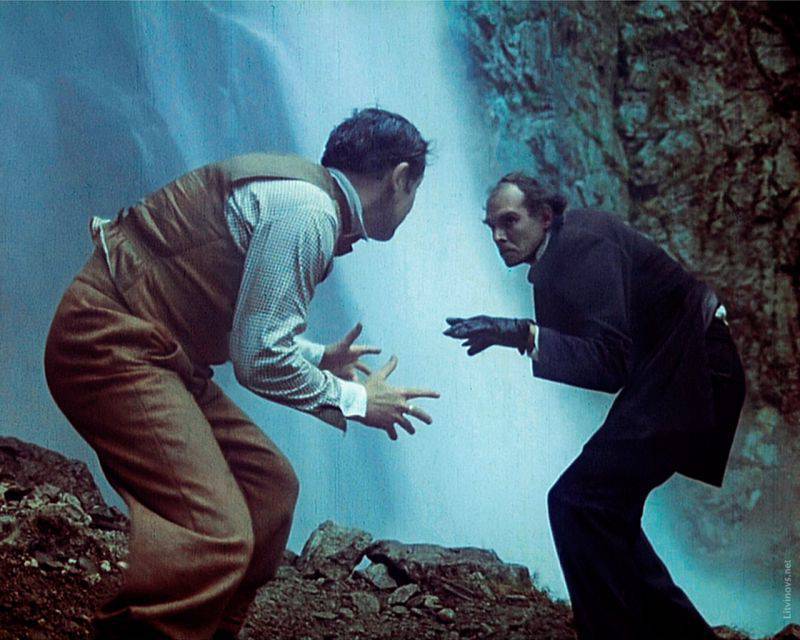Battle Profile-9: Bartitsu
Bartitsu from the story of Sherlock Holmes really existed. This is the progenitor of European self-defense, ahead of its time for a hundred years and once again confirmed the statement "everything new is well forgotten old." They practiced situational trainings, learned how to work against a group, trained in ordinary, street clothes and observed the rules of personal safety. Who came up with all this?
Sergey Viktorovich Mishenev, Director General of the International Academy of Fencing Arts, President of the Russian Bartitsu Club, reports.
General issues:
1. Characteristic style (school, direction) in one sentence
- You can even in one word: self-defense. Now it sounds trite, but at the turn of the XIX - XX centuries it was a completely new concept, based not on the idea of sports or class, aristocratic martial art, which then was fencing, but on the idea of street security and elementary protection from robbers and aggressive vagrants. And this self-defense, according to the idea of the founding father, should have been available to everyone: both law-abiding gentlemen, far from sports, and weak women.
2. Style motto (schools, directions)
“I really like the statement made by Boris Akunin, Masiharo Sibato, a Japanese:“ ... I couldn’t hear about the deadly fight, I could not even imagine what kind of hieroglyphs could be used to write such a word. ” The motto is not very similar, however, in my opinion, it very accurately reflects the essence of the “Japanese” struggle, its adventurous nature and the peculiar degree of mystery surrounding this original art.
3. The origins (beginning) of the direction (when and who founded)
- The founder of bartitsu is well known. This is English master Edward William Barton Wright. Actually, his name is ciphered in the name of the school “bartitsu”: the first part of the word (bart) is on behalf of Barton, and the ending (itsu) is from the jujutsu that was popular in those years.
Barton Wright was born on November 8 1860 in India, in the family of a railroad worker. The colonial policy of Great Britain forced the family to constantly move from place to place, but the future martial arts master only benefited. He spent his childhood in exotic countries, the last of which was Japan, where, by his own assertion, he was tempered in incessant street battles with the local population.
So Edward William got his first self defense lessons. Subsequently, his exotic skills and became one of the foundations of bartitsu.
Another component of this type were European technology - French and English boxing, as well as fencing with a cane, which became the main weapons bartitsu.
In addition, Barton Wright added elements of Swiss belt wrestling Schwingen to Bartitsu, and an original system of physical training.

4. The ultimate goal of the class (the ideal to which the student is going) is the physical and mental qualities that he must acquire.
- The original concept of bartitsu - self-defense - is relevant to this day. Absolute security - this is the goal proclaimed by Barton Wright, stating that an adept Bartitsu can always protect himself on the street, regardless of the number and armament of detractors. To achieve this goal, the master must not only master the techniques of self-defense, but also always remain calm and attentive. In addition, Barton Wright has developed a whole program of the proper behavior of a gentleman on the street. For example, approaching the intersection, one had to go around the corner of the house along the largest radius in order to avoid a surprise attack from around the corner; the raincoat was recommended to be simply thrown over the shoulders, without putting arms into the sleeves, so that it could be easily dropped and used as a weapon ... Interestingly, Bruce Lee gave his students almost the same recommendations a few decades later.
5. Teaching methods
- The method of teaching at the Academy was based on modeling street situations. At the same time, all classes were held in street clothes in order to be as close as possible to the potential street situation. Bartitsu techniques were studied in a kind of etudes: the master goes down the street, the robber attacks, and so on.
In addition, students had to study four additional disciplines, on the basis of which Bartitsu was based: Ju-Jitsu, English boxing, French Savat boxing and fencing with a cane. Each direction in the Academy was taught by a separate specialist. So, for example, Jiu-Jitsu was headed by the famous Japanese master Yukio Tani, and the fencing with a cane was headed by Swiss fencing master Pierre Vigny.
An additional class of old fencing was also opened at the Academy, where students experimented with medieval swords, Renaissance rapiers and other antique weapons. This section was led by English captain Alfred Hatton.
6. Used equipment (shock, wrestling, zalomnaya, etc.)
- The concept of bartitsu initially stated diversity and the absence of restrictions. Therefore, in theory, an adherent of this direction should have equally mastered the entire arsenal of martial arts. However, an analysis of the techniques that have survived to the present day in the form of photographs with descriptions demonstrates the prevalence of throws and creases. The blows with hand and foot are more likely preparatory and do not look crushing. It can be said that the strike technique in bartitsu concentrated in the field of weapons (walking stick). It is the cane most often used for striking the head. At the same time, Barton Wright considered it best for self-defense to be the cane with a heavy knob, and not with a hook, although the latter provides many possibilities for various hooks and throws.

7. Direction tactics
- The main tactical model Bartitsu - provocation. That is, the use of enemy aggression and management. Most of the techniques begin with this tactical element. For example, if an adversary is armed with a cane, the adept bartitsu will, as it were, accidentally overly push his left arm forward. The enemy strikes the arm, but anticipating such an attack, the master easily withdraws his arms and, in turn, strikes himself on the head with a crushing blow.
Or, the fighter puts his head under the blow, jumps to the side in time, and catches the attacker on the front leg, making hooking.
8. The presence of training battles (sparring). In what form, according to what rules are held?
- In Bartitsu competitions are not practiced at all. The idea of a competitive (initially equal) sports match in general contradicts the concept of bartitsu based on a sudden attack, unequal numbers, unequal and diverse weapons.
9. Physical training (general and special) - including work with weights, free weights, your weight
- Bartitsu developed in those years when various gymnastics, such as Swedish, German, Czech, gained great popularity ... Therefore, historically, master Bartitsu had the opportunity to practice body training with the help of appropriate projectiles. First of all, such equipment was a ladder and a bench (Swedish gymnastics), as well as a gymnastic horse and a rope (German gymnastics).
Also, the Bartitsu system included its own physical fitness system, but there is practically no information about it. It can be assumed that it was based on the use of its weight, and exercises with a partner.
10. Work against the group
- Work against a group of attackers is one of the components of bartitsu. Counteraction to the group was mainly built through maneuvering. The fighter tried to build opponents in such a way as to be able to hit each of them in turn, avoiding simultaneous attacks from different lines.
11. Work against weapons / with weapons
- Also one of the key themes of bartitsu.
Initially, not only the main, but the only weapon Bartitsu was a cane. However, very quickly the knife entered the arsenal, as the decisive argument of the majority of the attacking robbers.
Then the arsenal continued to expand, taking more and more unusual objects as weapons. First, Barton Wright added tricks with an umbrella, then a chair appeared. Finally, in the 1903 year (the last year of the Academy’s work), a completely unprecedented self-defense weapon appeared - a bicycle. Barton Wright himself said that this idea came to him from practical experience. Allegedly, once during a bicycle ride, he was attacked by detractors. Edward William, of course, managed to fight back, but could not hit his opponents, who safely escaped. To similar troubles did not happen, he developed several techniques with the bike.
12. Work on the ground (in the stalls)

- Theoretically, this section should have been developed in bartitsu. However, there are no such techniques in the works of Barton Wright. Apparently, the idea that during the battle and the gentleman may be on the ground, has not yet been formed.
13. Work in non-standard conditions, from non-standard opponents (in water, in darkness, confined space, from a dog, etc.)
- Non-standard conditions are close to the concept of bartitsu. Closed close space or visibility restriction (darkness) should have played a large role in the preparation of the universal fighter. But, apparently, such exercises were behind the scenes, and were not included in the known to us arsenal bartitsu.
14. Psychological training
- I think that the very idea of self-defense, which was new, unprecedented and unusual, was partly responsible for the psychological preparation of the fighter Bartitsu at the beginning of the 20th century. It is now, every second (and even more) man somehow in his life came into contact with the martial arts. And in those days it was a rather rare occurrence. Moreover, not martial arts in general, but self-defense. That is an idea that allows a gentleman to remain completely safe in any situation. This formed a special image of an adept bartitsu - strong, fearless, calm, attentive. In January, journalist Mary Nugent’s 1901 wrote about the Academy: “A huge underground hall, white tiles sparkling with white tiles, electric lights and champions roaming like tigers.”
15. Other effects from occupations (improving, developing and etc.)
- It is known that, in addition to the martial arts, Burton Wright was seriously interested in healing. The Bartitsu system included therapeutic procedures involving the use of heat, vibrations, light, and various radiations.
Later, after the closure of the Academy, Barton Wright continued his professional work precisely as a healer. Moreover, his methods of treatment, he also called bartitsu ...
16. Unique features of the direction (style, school)
- At the turn of the XIX - XX centuries, almost every feature of Bartitsu was its unique feature. A new, unprecedented phenomenon was the very idea of self-defense, a new step was the unification of styles of East and West, the use of improvised items as a weapon was new, the treatment of stories martial arts (Alfred Hutton's class of old fencing). However, now it is impossible to surprise any of the above. In the modern world, Bartitsu is more of an original passion that combines martial art, love of history, trendy steam-punk and detective motifs in the style of Sherlock Holmes.
Perhaps that is why modern bartitsu has visibly moved away from the original ideas, and even gave rise to a new phenomenon — neabortitsu. The authors of this direction say that neartits is the kind of bartits it could become now if the Academy had not closed in 1903, and would have existed to this day. The idea is interesting, but not indisputable. In any case, the main form of incarnation of neartits today is stage fights. Technically, this may be close to the ideas of the Barton Wright variety, but ideologically unlikely.
17. Application in life (a case of self-defense, when the student was able to protect himself in this direction).
- But there is such an example in our practice. And, oddly enough, he is connected precisely with the practice of neo-arthits, that is, with the stage direction.
One of our teachers, Galina Chernova, after rehearsing a staged battle, was attacked by a raider who snatched a mobile phone from her. Galina caught up with him, and joined the battle, during which, unconsciously, she used one of the techniques that she practiced during the rehearsal. She jerked his shoulder, turning it frontally, and grabbed her left hand behind the barrel, and swung her right for a particular straight in the nose and shouted: "Give me my phone!". Reception brought victory. What is most interesting - we practiced that technique at that rehearsal.
There is an example from the legend of Barton Wright. He was illustrated by another our instructor who was not engaged in bartitsu. He was attacked while cycling. Next - all the scenario of the founding father. I was able to repel the attack, but the bike prevented to hit the enemy. The attacker went unpunished.
Add. questions:
18. Why is such an interesting and innovative Academy closed?
- On the closure of the Academy. Here is a snippet from my article on bartitsu:
Bartitsu Academy could not stand the competition with more traditional and (importantly) cheaper clubs. Additional difficulties arose because of several unsuccessful demonstrations, where the proteges of Burton-Wright "stained" the reputation of Alma Mater. To top it all, the most reputable academy instructors, such as the Japanese masters Yukio Tani and Sadekazu Uyenishi and Swiss authority Pierre Vigny, suddenly opened their own schools, the first students of which became as they should be in such non-gentlemen cases, customers who come to the Barton Wright advertising company.
The founder of the school could not stand this blow. Already in 1903, the Academy of Arms and Physical Culture closed forever ...

Information